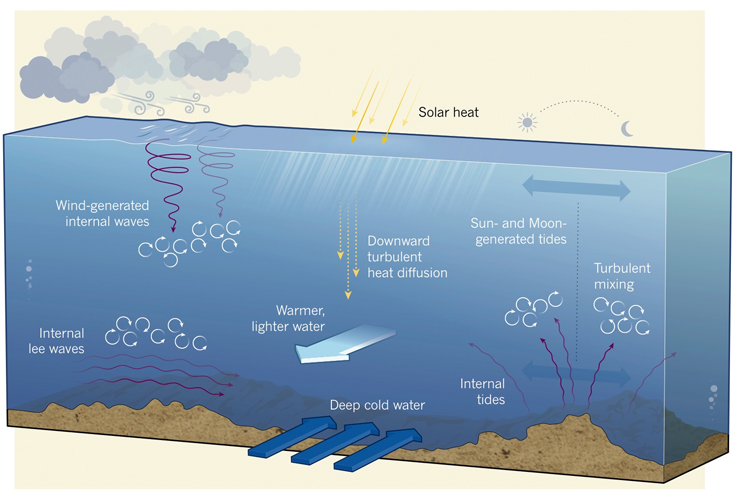If there's one thing that we can easily visualize quickly, it is waves. They move, morph, and break. We can see, hear, and touch them.
But what if there were nearly invisible undulations that travel thousands of miles under the surface of the world's oceans?
The phenomenon is called internal waves, and it is, believe it or not, more common than one would imagine.
Like regular surface waves that we observe marching from the horizon toward the coastline, internal waves are also gravity waves.
The only difference is that they're hidden beneath the ocean, and their presence is hardly noticeable.
They carry energy like any other wave, but they feature some curious and differentiating characteristics.
Internal waves travel between distinct water layers, with different densities (saltier or fresher) or even temperatures (lower or higher).
Imagine a layer cake, with each layer having a slightly different weight. The boundaries between these layers are where these underwater ocean disturbances are born.
"Imagine pulling a parcel of water down into more dense water, then letting it go; it will rise because it is less dense than its surrounding water," explains Willard Bascom and Kim McCoy, authors of the book "Waves and Beaches."
"But when it has risen enough to be neutrally buoyant, it continues to move as its inertia causes it to rise into less dense water."
"When its upward motion stops, it sinks back downward. This repeating process is the essence of internal wave motions."
But how and where do these unique underwater swells form?

The Formation of Internal Waves
At the heart of internal waves lies a simple principle: they form at the interfaces between layers of water with different densities.
Consider a parcel of water, lighter than its surroundings, displaced downward.
Upon release, it bounces back up due to its buoyancy, overshooting into less dense waters above and then falling again, creating a wave-like motion.
This oscillation is akin to a weight bobbing on a spring, with buoyancy acting as the restoring force.
In theory, an internal wave can be set in motion by moving atmospheric pressure fields, variable wind stresses, surface waves, tides, ships, and downward-moving or upward-moving currents.
Many mechanisms contribute to the formation of this phenomenon, but a predominant one involves tidal forces sloshing water over undersea features like ridges and canyons.
This interaction disturbs the density layers in the ocean, setting off these colossal underwater waves.
A striking example can be seen in the South China Sea, where tidal flow through the Luzon Strait generates some of the largest internal waves observed, reaching up to 558 feet (170 meters) in height.
"The wave periods, lengths, and heights of internal waves can be very much greater than those of surface waves," add Bascom and McCoy.
"Although the heights may be large - over 330 feet (100 meters or more) - the energy these waves contain is smaller than surface waves, and the typical velocity is low, averaging less than 1 foot per second (30 centimeters per second)."
Impact on Ocean Dynamics and Climate
Internal waves are dynamic agents in oceanic processes. They play the following roles.
- Nutrient and Pollutant Dispersion: Internal waves tirelessly work to mix nutrients and disperse pollutants. This mixing is especially critical where river waters, carrying different densities, meet the ocean or where glacial and sea ice meltwater enters the sea;
- Biological Productivity: The intermittent mixing caused by these waves can uplift phytoplankton into sunlit surface waters, boosting biological productivity. This effect is vital for the health of marine ecosystems, as phytoplankton form the base of the oceanic food chain;
- Global Climate Impact: With an estimated power dissipation comparable to human energy consumption, internal waves significantly influence the ocean's energy balance. They facilitate the sinking of cold, dense water in polar regions and its subsequent mixing with upper layers, maintaining a steady state in the ocean's depths. This mixing can also draw atmospheric carbon dioxide into the ocean's abyss, highlighting the role of internal waves in carbon sequestration and climate regulation;
The Bermuda Mystery: A Case Study
A real-world example of the mysterious nature of this oceanic event comes from the deep waters off Bermuda.
In the early 1990s, autonomous vehicles programmed to descend to 3,000 feet (915 meters) and return encountered unexpected delays.
The culprit? Immense internal waves, 330 feet (100 meters) in height, on which the neutrally buoyant vehicles were inadvertently "riding."
The revelation has since informed the study of underwater wave motions and their broader implications for ocean mixing and biology.
